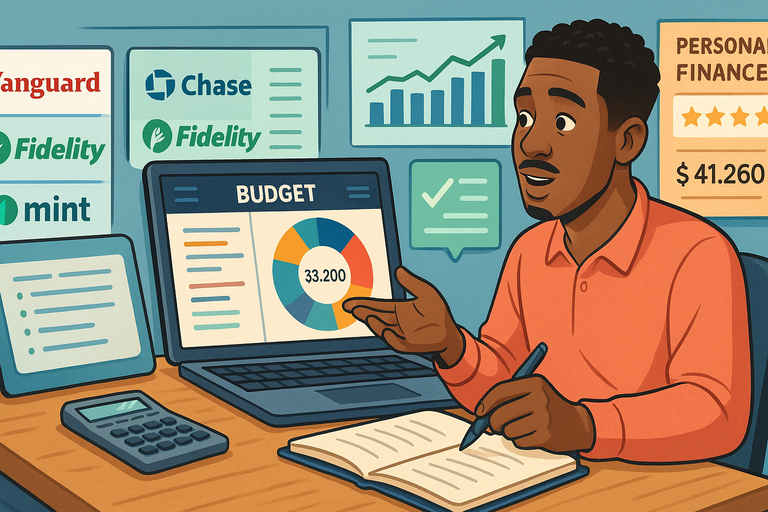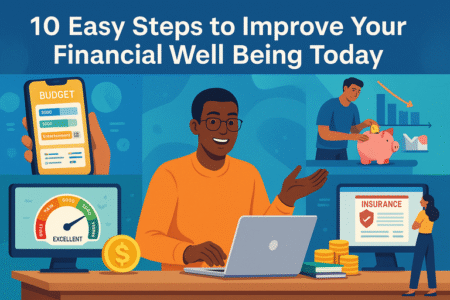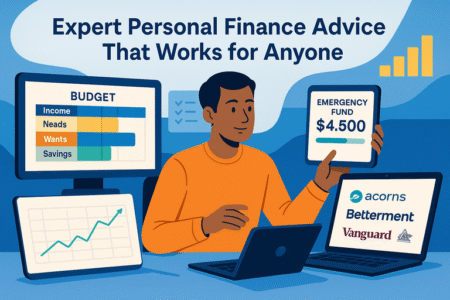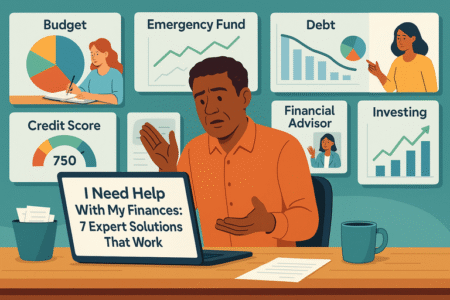Table of Contents
A personal financial guide isn’t just about budgeting—it’s about building a life where your money works for you instead of against you.
Do you ever wonder how to get out of debt faster, save for the future without giving up what you enjoy today, or finally feel in control of your paycheck?
This guide answers those questions step-by-step, showing you how to grow wealth, avoid common money traps, and make smarter decisions with confidence.
Building A Strong Foundation For Financial Success
Everything about money starts here. Without a solid base, every other step feels shaky. This foundation isn’t glamorous, but it’s what gives you confidence when bigger financial decisions come your way.
Mastering The Basics Of Income And Expenses
Think of your finances like plumbing: money flows in through income, flows out through expenses, and leaks appear if you don’t track them. If you’ve ever said, “I don’t know where my paycheck goes,” that’s a sign it’s time to pay closer attention.
Start by writing down your monthly income—every source, not just your main job. Then list your expenses. Separate them into fixed (rent, insurance, car payment) and variable (groceries, dining out, subscriptions). The act of separating these categories already shows you where flexibility exists.
One tip I’ve used myself: open your banking app and scroll through three months of transactions. Highlight anything you don’t even remember spending on. That’s where silent leaks happen.
Once you know your inflow and outflow, you gain power—you can redirect money toward your actual goals instead of letting it vanish.
How To Create A Realistic Budget That Sticks
Budgets often fail because they’re built like punishment plans—cutting out all fun and flexibility. I suggest building what I call a “freedom budget.” Here’s how:
- Calculate essentials (rent, utilities, groceries, transportation).
- Assign 20% toward savings or debt repayment.
- Leave 10–15% as guilt-free spending (yes, coffee or nights out).
Use a simple app like YNAB (You Need A Budget). In YNAB, for example, you assign every dollar a job. When you overspend in one category, the app prompts you to move money from another—teaching discipline without guilt.
A realistic budget feels like a roadmap, not a straitjacket. The trick isn’t perfection—it’s sustainability.
Setting Short-Term And Long-Term Money Goals
Goals give your money purpose. Without them, saving feels like deprivation instead of progress. I like to break them into two buckets:
- Short-term: 1–3 years. Think vacation savings, paying off a credit card, or buying a reliable used car.
- Long-term: 5+ years. Think retirement, buying a home, or building an investment portfolio.
A neat trick: name your accounts. Instead of “Savings Account,” label it “Summer Trip 2025” or “First Home Fund.” Seeing the name when you log in keeps the goal real and motivates you to stick to your plan.
Use SMART goals—specific, measurable, achievable, relevant, and time-bound. “Save $5,000 for a car by next August” is far more actionable than “Save money for a car.” When your goals feel concrete, your spending decisions naturally align with them.
Smart Strategies To Eliminate Debt Faster
Debt is like financial quicksand—the longer you stay stuck, the harder it feels to climb out. But with the right strategies, you can break free faster than you think.
Choosing The Right Debt Repayment Method
The two classic methods are the snowball and the avalanche.
- Snowball: Pay off the smallest debt first, then roll that payment into the next. It’s motivating because you see quick wins.
- Avalanche: Pay off the highest-interest debt first. It’s mathematically smarter because you save more in interest over time.
In my experience, start with snowball if motivation is your struggle, avalanche if interest is suffocating you. Some people even mix the two—knock out a small balance for momentum, then switch to avalanche for efficiency.
Negotiating Interest Rates And Payment Terms
Here’s something most people don’t realize: you can often just call your credit card company and ask for a lower interest rate.
A polite script might sound like: “I’ve been a loyal customer, but the rate is too high. Can you lower it?” You’d be surprised how often they say yes, especially if you’ve got a good payment history.
If you have student loans, look into income-driven repayment plans. For personal loans, refinancing at a lower rate can free up hundreds each year. Even credit cards sometimes offer hardship programs if you ask.
The key: lenders would rather work with you than risk you defaulting.
Avoiding Common Traps That Keep You In Debt
Three habits keep people stuck:
- Making only minimum payments. This keeps you chained to interest.
- Taking on new debt while paying off old debt. It’s like trying to drain a bathtub while leaving the faucet running.
- Consolidating without changing habits. A debt consolidation loan can help, but if you don’t address spending patterns, you’ll end up with double the debt.
A smart move is to cut up (or freeze) cards you’ve paid off. Literally freezing a card in a block of ice forces you to think twice before digging it out. It’s silly, but effective.
Proven Saving Habits That Grow Your Wealth
Saving is less about big lump sums and more about consistent small actions that add up over time. The habits you build here create the wealth snowball that changes everything.
How To Automate Your Savings For Success
Willpower is unreliable. Automation removes the need to decide every month. Most banks let you set automatic transfers on payday. For example, set $100 to move from checking to savings every Friday. After a few months, you won’t even notice it’s gone.
If your employer offers direct deposit splitting, that’s even better—send a percentage straight to savings before it even hits your main account. Out of sight, out of temptation.
One approach I like: treat savings like a bill. Just as you’d never skip rent, you don’t skip your “payment” to yourself.
Creating An Emergency Fund That Actually Works
The rule of thumb is 3–6 months of expenses, but that can feel overwhelming. Start small—aim for $500, then $1,000. That alone protects you from dipping into credit cards for car repairs or medical bills.
Keep your emergency fund in a separate high-yield savings account. Ally and Marcus are popular options. That way, it’s earning interest but still accessible. Don’t keep it in the same account as checking—you’ll be tempted to dip into it.
One scenario: A friend’s car broke down and the repair cost $1,200. Because she had an emergency fund, it was an inconvenience—not a crisis. That’s the power of this safety net.
Practical Ways To Save Money Without Sacrifice
Cutting costs doesn’t mean living like a monk. Small adjustments make a big impact without killing joy.
- Cancel unused subscriptions—most people forget at least one.
- Switch to generic brands for basics like meds and pantry staples.
- Meal prep twice a week—you’ll save hundreds by skipping takeout.
- Call your internet or phone provider and negotiate a better plan.
One personal trick: I do a “no-spend weekend” once a month. Free activities only—hiking, library books, cooking at home. It resets spending habits and makes me appreciate little luxuries again.
Saving is about alignment, not austerity. When your spending matches your values, saving feels natural.
Investing Made Simple For Everyday People
Investing doesn’t have to feel intimidating. It’s really about making your money grow while you sleep. If you’ve ever thought investing was only for Wall Street pros, I promise that’s not true.
With a little knowledge and the right tools, you can start today.
Understanding The Power Of Compound Growth
Compound growth is where the magic happens. Imagine planting a tree. At first, it’s small, but as it grows, it produces more seeds that grow into more trees. That’s what happens with money earning returns—it generates its own returns, and the cycle snowballs.
For example, if you invest $200 a month at a 7% average annual return (pretty standard for the stock market), in 30 years you’ll have about $240,000—not just because of what you put in, but because of compounding. If you start 10 years later, you’ll end with almost half that.
The takeaway: start as early as possible, even if it’s small. Compounding rewards time more than it rewards big sums.
How To Choose The Right Investment Accounts
Here’s where people often get stuck: “Do I invest in a brokerage account, a 401(k), or an IRA?” Think of accounts as buckets. The investments inside (stocks, bonds, ETFs) are what grow your money, but the type of bucket determines tax advantages.
- Employer 401(k): Great if you get a match—it’s basically free money.
- IRA (Individual Retirement Account): Lets you grow money tax-free or tax-deferred.
- Brokerage account: Flexible, no contribution limits, but no tax perks.
I recommend starting with employer-sponsored plans if they offer matching, then opening an IRA. Once those are maxed, use a brokerage account for extra investing.
On platforms like Vanguard, Fidelity, or Schwab, you can open an account in under 15 minutes.
Diversifying Your Portfolio For Long-Term Stability
Putting all your money in one stock is like putting your life savings on red at a casino—it might pay off, but the risk is huge. Diversification spreads your money across different assets so one bad investment doesn’t sink you.
A simple starting point: use a total stock market index fund (covers the whole market) and a bond fund (for stability). A common beginner-friendly split is 80% stocks, 20% bonds if you’re young, and gradually shifting more toward bonds as you near retirement.
Many platforms even offer “target date funds,” where you pick the year you plan to retire, and the fund automatically adjusts your risk for you. It’s hands-off and beginner-friendly.
Planning For Retirement With Confidence
Retirement planning isn’t about age—it’s about freedom. You’re planning for the day when work becomes optional, not required. The earlier you think about it, the smoother the path will be.
Calculating How Much You Really Need To Retire
A common rule of thumb is the 4% rule: if you withdraw 4% of your retirement savings each year, you’re likely to make it last 30 years. That means if you want $40,000 per year, you need about $1 million saved.
But don’t panic—this isn’t a one-size-fits-all number. Consider:
- Your lifestyle (modest living vs. luxury).
- Where you’ll live (retiring in a small town is cheaper than New York City).
- Healthcare costs (often underestimated).
I suggest using a retirement calculator from Fidelity or Vanguard. Plug in your numbers—it shows you how much to save monthly to hit your target. It’s eye-opening, but empowering.
Why Employer-Sponsored Plans Shouldn’t Be Ignored
If your job offers a 401(k) or similar plan, don’t leave free money on the table. Many employers match your contributions up to a percentage.
For example, if they match 50% of your contributions up to 6% of your salary, and you earn $60,000, that’s $1,800 of free money each year.
On your online 401(k) portal, check for “Contribution Rate” or “Change Contributions.” Set it to at least the match percentage. Even if you can’t max it out, capturing the match is the smartest first step.
Making The Most Of IRAs And Other Retirement Tools
An IRA (Individual Retirement Account) gives you flexibility. You can open one with a bank or brokerage.
- Traditional IRA: Contributions may be tax-deductible now, but withdrawals are taxed later.
- Roth IRA: Contributions are taxed now, but withdrawals in retirement are tax-free.
I personally love Roth IRAs because of the tax-free growth—you know exactly what’s yours in retirement. Contribution limits are lower than 401(k)s, but they’re a fantastic supplement.
Other tools like HSAs (Health Savings Accounts) also act like hidden retirement accounts if you don’t spend the funds. The triple tax advantage makes them incredibly powerful.
Protecting Your Finances With Insurance And Safety Nets
Building wealth is exciting, but protecting it is equally important. Insurance and safety nets may not feel glamorous, but they’re your financial shield against the unexpected.
Choosing The Right Insurance For Your Life Stage
Insurance needs change as your life evolves. Here’s a quick roadmap:
- In your 20s: Health insurance (non-negotiable) and renter’s insurance if you don’t own a home.
- In your 30s–40s: Add life insurance if you have dependents, and disability insurance (often overlooked but crucial).
- In your 50s+: Consider long-term care insurance and review your life insurance coverage.
When shopping, I recommend term life insurance over whole life for most people. It’s cheaper and does the job—protects your loved ones if something happens.
How To Protect Yourself From Financial Emergencies
Think of your emergency fund as the first layer of defense, but beyond that:
- Keep your credit score healthy. It gives you access to lower interest rates if you need a loan.
- Maintain adequate insurance deductibles—you don’t want a $5,000 out-of-pocket surprise.
- Build multiple income streams if possible (side hustle, rental, dividends).
One personal example: I once had a $2,000 medical bill come out of nowhere. Because I had both insurance and an emergency fund, it was manageable—not a debt trap. That’s the power of planning ahead.
The Role Of Estate Planning In Securing Your Legacy
Estate planning isn’t just for the wealthy—it’s for anyone who wants control over what happens to their assets. At minimum, set up:
- A will (who gets what).
- A power of attorney (who makes decisions if you can’t).
- A healthcare directive (your wishes for medical care).
If you own property or have significant assets, a trust might make sense to avoid probate. It keeps things smoother for your family and can even reduce taxes.
Think of estate planning as a final act of love—it spares your family from confusion, stress, and financial mess during an already difficult time.
Smarter Spending Decisions That Boost Your Future
Spending money is unavoidable, but how you spend makes all the difference. Smarter spending doesn’t mean cutting out everything fun—it means making choices that line up with your values and long-term goals.
Recognizing Wants Versus Needs In Daily Life
This sounds simple, but it’s surprisingly tricky. Needs are essentials like food, housing, healthcare. Wants are everything else—streaming subscriptions, new shoes, dining out. But here’s the nuance: not all wants are bad.
I recommend doing a “needs check” before purchases. Ask: “If I lost my job tomorrow, would I still pay for this?” If the answer is no, it’s a want.
One practical tip: Use two debit cards—one tied to your essentials budget, and one to discretionary spending. When the “fun money” card runs out, you know you’ve hit your limit without touching your essentials. It’s like building a speed bump for your wallet.
How To Spend Guilt-Free On What Truly Matters
Guilt-free spending comes down to intentionality. If you value travel, it’s okay to spend generously there—just trim in areas you care less about. I cut back heavily on eating out so I can funnel that money toward experiences with my family.
A strategy I suggest: The 70/20/10 method.
- 70% for essentials and lifestyle expenses.
- 20% for saving or debt repayment.
- 10% for guilt-free spending.
That 10% is important. It prevents burnout and makes your budget livable. When spending aligns with your priorities, you stop feeling guilty because you know you’re still on track.
The Psychology Behind Making Better Money Choices
Money decisions are rarely logical—they’re emotional. Retail therapy, impulse buys, keeping up with friends—these aren’t math problems, they’re mindset problems.
Try these psychological hacks:
- Wait 24 hours before big purchases. Often the urge fades.
- Unsubscribe from marketing emails. Out of sight, out of mind.
- Use cash for discretionary spending. Handing over real bills makes the cost feel more tangible.
I once froze my Amazon app for a month and noticed how much less I “needed.” Changing the environment around your money choices often works better than raw willpower.
Building Credit And Using It Responsibly
Credit is like your financial reputation. Used wisely, it opens doors to lower rates and more opportunities. Used poorly, it can weigh you down for years.
Steps To Improve Your Credit Score Quickly
Your credit score is built on five main factors:
- Payment history (always pay on time).
- Credit utilization (keep balances under 30% of your limit).
- Length of credit history (the older, the better).
- Mix of credit types (credit cards, loans, etc.).
- New inquiries (too many in a short time can hurt).
If you want a quick bump, focus on utilization. If your card has a $5,000 limit, keep your balance under $1,500. Even paying down $200–$300 can raise your score within weeks.
Smart Ways To Use Credit Cards Without Debt
Credit cards can be tools or traps. The trap is minimum payments and high interest. The tool is rewards and protection.
Here’s how to use them safely:
- Set up autopay for the full balance every month.
- Use one card for essentials (groceries, gas) and pay it off like clockwork.
- Collect rewards points only if you’re disciplined. Free flights aren’t worth debt.
I personally treat my card like a debit card—if I wouldn’t buy it with cash, I don’t buy it on credit. That mindset saves me from creeping balances.
How To Monitor And Protect Your Credit Report
Check your credit report at least once a year through AnnualCreditReport.com—it’s free. Look for errors (wrong balances, accounts you don’t recognize). Mistakes happen, and they can drag your score down unfairly.
For ongoing monitoring, apps like Credit Karma or Experian give you regular updates. Turn on fraud alerts if you’ve ever had your information exposed in a breach.
One client I advised caught a fraudulent account early this way—it saved him years of damage repair. Watching your credit isn’t paranoia, it’s protection.
Using Technology To Simplify Your Financial Life
Money management doesn’t have to be spreadsheets and headaches. The right apps and tech can make tracking, saving, and investing almost effortless.
Best Apps To Track Spending And Budgets
If you’re still budgeting on paper, apps can save you hours. A few standouts:
- YNAB (You Need a Budget): Every dollar gets a job. Great for structure.
- Mint: Tracks all accounts in one dashboard with automated categorization.
- PocketGuard: Shows you how much is “safe to spend” after bills.
For example, Mint’s dashboard lets you click “Budgets > Create Budget” and set caps for groceries, dining, or gas. Each transaction updates in real time. Seeing the numbers visually is far more powerful than guessing.
How Robo-Advisors Can Help You Invest Smarter
Not everyone wants to handpick stocks. Robo-advisors like Betterment or Wealthfront automate investing. You answer a questionnaire about your goals, and the platform builds and rebalances your portfolio for you.
Think of it like cruise control for investing. For someone new, this can remove fear and analysis paralysis. You don’t have to know ETFs from mutual funds—they handle it while you focus on contributing consistently.
Staying Safe With Online Banking And Fintech Tools
With convenience comes risk. Protect yourself with a few simple habits:
- Enable two-factor authentication on all financial apps.
- Avoid public Wi-Fi for transactions.
- Use unique passwords stored in a password manager.
I once logged into my bank while traveling without VPN and had a fraud alert within 24 hours. That was enough of a scare to never repeat it. Convenience is wonderful, but security has to be a priority.
Developing A Lifelong Money Mindset
The personal financial guide isn’t just about tools—it’s about mindset. Habits, consistency, and motivation are what turn short-term wins into lifelong success.
How To Stay Motivated On Your Financial Journey
Motivation fades unless you keep your goals visible. I suggest:
- Track progress visually (charts, milestone trackers).
- Reward yourself for milestones—celebrate paying off a card with a nice dinner.
- Surround yourself with like-minded people. Join communities or follow personal finance creators for encouragement.
Seeing progress fuels momentum. It’s like fitness—the first 10 pounds lost inspire you to keep going.
Learning From Mistakes Without Losing Momentum
Everyone makes money mistakes. I’ve missed payments, overspent, even ignored my budget for months. The key is not perfection—it’s bouncing back.
Ask: “What can I learn here?” instead of “Why am I so bad with money?” For example, if you blew your grocery budget, maybe you need to meal prep differently, not just “try harder.”
Mistakes are data points, not death sentences. Use them to fine-tune your system.
Building Habits That Lead To Generational Wealth
Generational wealth isn’t just about millions in the bank—it’s about leaving stability and knowledge for the people who come after you. The habits you build now—saving consistently, investing wisely, protecting assets—become the model for your kids, family, or even your community.
One practice I recommend: document your money systems. Keep a simple “financial playbook” with account logins, bill schedules, and insurance details. If something happens, your loved ones aren’t left scrambling.
Long-term wealth is less about big windfalls and more about consistent, boring discipline repeated for decades. That’s how empires are quietly built.
Pro tip to close the full guide: A personal financial guide isn’t something you read once—it’s something you live. Take one step at a time, automate what you can, and remind yourself that progress—even slow progress—is still progress.






